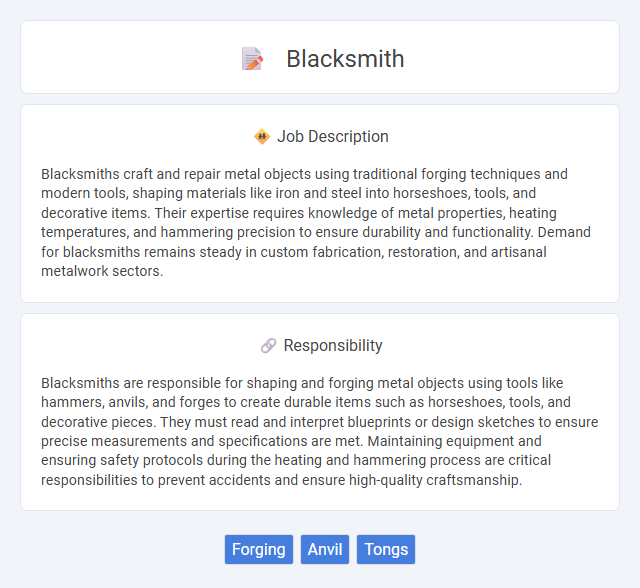
Blacksmiths craft and repair metal objects using traditional forging techniques and modern tools, shaping materials like iron and steel into horseshoes, tools, and decorative items. Their expertise requires knowledge of metal properties, heating temperatures, and hammering precision to ensure durability and functionality. Demand for blacksmiths remains steady in custom fabrication, restoration, and artisanal metalwork sectors.
Individuals with strong physical endurance and good hand-eye coordination are more likely to thrive as blacksmiths due to the job's demanding nature and precise craftsmanship requirements. Those who prefer working outdoors or in well-ventilated workshops and can tolerate high temperatures are better suited for this role. People with patience and attention to detail may find greater success while those sensitive to heat or heavy manual labor might face challenges in this occupation.
Qualification
A blacksmith requires a blend of technical skills and hands-on experience, typically gained through apprenticeships or vocational training programs. Proficiency in metalworking techniques such as forging, welding, and heat treatment is essential, along with knowledge of different types of metals and their properties. Strong physical stamina, attention to detail, and the ability to read blueprints or technical drawings are crucial qualifications for succeeding in this trade.
Responsibility
Blacksmiths are responsible for shaping and forging metal objects using tools like hammers, anvils, and forges to create durable items such as horseshoes, tools, and decorative pieces. They must read and interpret blueprints or design sketches to ensure precise measurements and specifications are met. Maintaining equipment and ensuring safety protocols during the heating and hammering process are critical responsibilities to prevent accidents and ensure high-quality craftsmanship.
Benefit
Blacksmiths likely experience the benefit of developing specialized metalworking skills that can lead to high demand in artisanal markets and custom fabrication industries. The profession may offer opportunities for creative expression through the design and crafting of unique metal items, enhancing job satisfaction. There is a strong probability that skilled blacksmiths enjoy stable employment prospects, especially in sectors valuing traditional craftsmanship paired with modern techniques.
Challenge
The blacksmith job likely involves significant physical challenge, requiring strength and endurance to shape metal effectively. Precision and skill in manipulating tools may present cognitive difficulties, especially when working with complex designs or materials. Risks related to heat and heavy equipment suggest the profession has inherent safety hazards that require constant attentiveness.
Career Advancement
Blacksmiths enhance their career opportunities by gaining expertise in advanced metalworking techniques and specializing in areas such as tool making, artistic forging, or industrial fabrication. Pursuing certifications from professional bodies like the American Bladesmith Society or the National Association of Blacksmiths can significantly boost credibility and job prospects. Experienced blacksmiths often advance to supervisory roles, open custom workshops, or become instructors in trade schools, expanding their influence in the craft.
Key Terms
Forging
Forging is a fundamental process in blacksmithing that involves heating metal to high temperatures before shaping it with hammers and anvils. This technique enhances the metal's strength and durability by altering its internal grain structure. Blacksmiths skilled in forging produce tools, weapons, and decorative items with precise control over metal properties and form.
Anvil
A blacksmith relies heavily on the anvil as a fundamental tool for shaping and forging metal. This robust, flat-topped iron or steel block provides a solid surface essential for hammering, bending, and cutting heated metal pieces. The anvil's design, including its horn and hardy hole, enhances precision and versatility in crafting tools, horseshoes, and intricate metalwork.
Tongs
Tongs are essential tools for blacksmiths, designed to securely grip and manipulate hot metals during forging. Various types of tongs, such as flat-nose, pick-up, and bolt tongs, provide precision and control when shaping iron and steel. Mastery in using tongs enhances safety and efficiency in blacksmithing, enabling craftsmen to handle high temperatures and intricate workpieces effectively.
 kuljobs.com
kuljobs.com